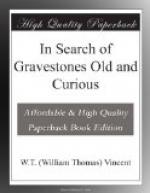The clergy were always the masters in such matters, and their influence is seen in many places, even in the villages, in keeping the churchyard free from ridicule; but, broadly speaking, there is no doubt that the rectors and vicars in London and other large cities began quite a hundred years earlier than those of the villages that control and supervision over the carving and inscriptions on the tombstone which is now the almost universal rule. It was unquestionably the adoption of this practice by the country parson, late in the eighteenth century or early in the nineteenth century, that put an end in rural places to the “period” of illustrated epitaphs which had long gone out of fashion, or, more likely, had never come into being, among the busier hives of humanity.
A rare variety of the cloud-and-angel series, which are so frequent, is seen in Longfield Churchyard on the Maidstone Road. Trumpets of the speaking or musical order are frequently introduced to typify the summons to resurrection, but here we have the listener pourtrayed by the introduction of an ear-trumpet.
[Illustration: Fig. 50. Woolwich.]
[Illustration: Fig. 51. Longfield.]
Fig. 51.—At Longfield.
“To Mary Davidge, died 1772, aged 69 years.”
Allegorical gravestones of recent date, that is of the time which we call the present day, are very seldom seen, and such as there are do not come within the scope of this work. There is one in West Wickham Churchyard devoted to a chorister, and sculptured with a representation of the church organ-pipes. Memorials to deceased Freemasons are perhaps the most frequent of late carvings, as in the sketch from Lydd in the Romney Marsh district.
Fig. 52.—At Lydd.
“To John Finn, died June 9th, 1813, aged 30 years.”
Occasionally, too, some plain device appears on even a modern headstone, such as the following, which is one of the few I have from the London area. The graves of the same half-century may be searched without finding many carvings more ambitious than this.
Fig. 53.—At st. JAMES’S, bermondsey.
“To Charles Thomas Henry Evans, died 1849.”
Churchyards beside the Upper Thames are nearly all prolific in old gravestones, the riparian settlements having been well populated during the favourable period. This is especially the case at Richmond and Twickenham, but of the great number of eighteenth-century stones in both churchyards there are few very remarkable. Richmond has a rare specimen of the full-relief skull. The death’s head has on either side of it the head of an angel in half-relief. The stone is a double one, and I have never met its fellow.
Fig. 54.—At Richmond.
“To Annie Smedley (?), died
1711, aged
90 years.”




